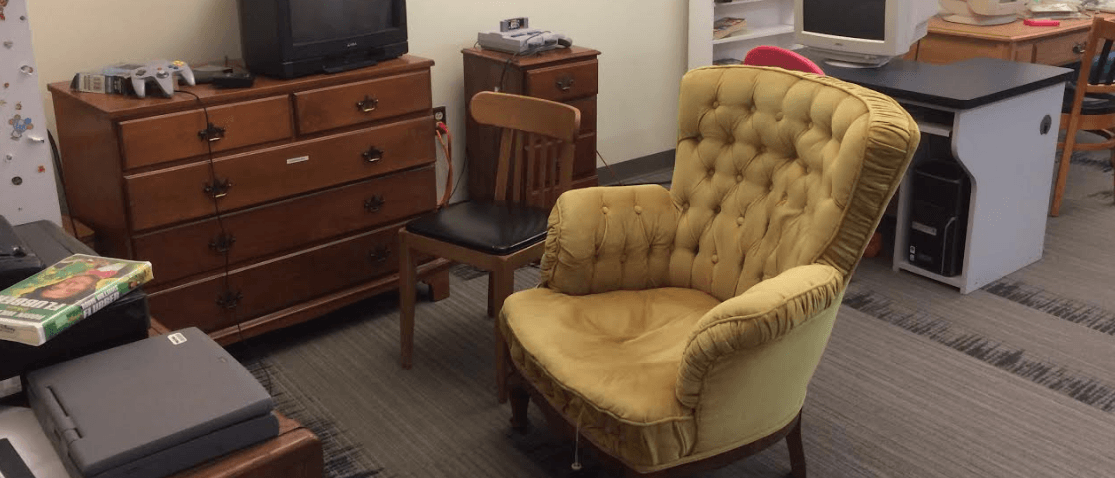UMW’s console living room
4 min read
Gemma Spicka-Proffit
By SARAH GOODNOUGH
Staff Writer
On the fourth floor of UMW’s Hurley Convergence Center, there is a corner that looks like a portal to the past. Stacks of old video games, ranging from Rush to Super Mario, bear notes indicating which student is mid-play. A shelf decorated with Lisa Frank stickers holds an old Nintendo Entertainment System, VHS tapes and a Walkman box. A few kitchen chairs and an old recliner offer students a place to sit in front of a vintage television. The scent of nostalgia hangs over it all, drawing students from across campus to relax and hang out away from the stress of their classes.
The Console Living Room is an exhibit of situated media technology: a recreation of a space in which one would have used these artifacts from past digital ages. While it started out just as a fun project, it quickly became a highlight of UMW.
“It allows students to reflect on technology, culture, and just general vibes of each decade,” said Dr. Gwen Hale, director of the Writing Center. “It truly is an interactive piece of art.”
One of the few things a student won’t find in the Console Living Room is a plaid couch, which was added as part of the ‘70s exhibit to complete its grunge aesthetic. While exuding a foul stench, it was the most iconic piece from the exhibit. It provided students a place to relax and get comfortable as if they were hanging out at home. However, it has since been done away with.
“It defined the space,” said senior English and psychology double major Kirsten Quarforth.
Without the ‘70s couch, the Console Living Room lacks a certain hominess that attracted so many students. Assistant Professor Zach Whalen, who heads the ongoing project, recognized the part that couch played in the exhibit and has decided to replace it. The latest addition to the room will be a ‘90s loveseat from communications and digital studies professor, Dr. Lee Skallerup Bessette.
“A comfy couch invites people to sit and gives them a sense of home, of hanging out with their friends, and fond memories,” said Dr. Hale. “Throw in some nostalgia and you have a winning combination.”
Whalen plans to place the loveseat in front of the old TV where students will be able to get comfortable while watching movies or playing their favorite games.
“I think it might be nice to have a place for multiple people to sit,” said Quarforth.
Some of the electronics available for students to use are a late ‘90s Mac computer, a Fisher Automatic Turntable and a Nintendo Entertainment System complete with Wolverine, Super Mario Bros and Teenage Mutant Ninja Turtles cartridges. There are a handful of comics like the 1985 The Avengers and the 1977 Fantastic Four, both volume one, and numerous VHS cassette tapes available to watch.
Whalen and Jim Groom, then director of the Division of Teaching and Learning Technologies, started the project in the spring of 2015 when the HCC was still quite new to the university. They wanted to supply the new building with PlayStation and Xbox games to go with the game consoles available for checkout at the front desk. Their discussion turned into a joke about whether or not they could checkout an Atari, an outdated video game console from the late 1970s.
At first it seemed ridiculous. Why provide a piece of outdated equipment for students to use, especially when the HCC featured a sleek and modern design? However, the more they talked about it, the less ridiculous it seemed. They asked themselves, “Why not?” That simple question spurred the birth of the Console Living Room.
Whalen and Groom outfitted the exhibit with furniture from Goodwill and things found in the UMW surplus warehouse, where unused or discarded furniture is stored until state regulations allow the school to dispose of it. In order to make the living room as authentic looking as possible, they worked with a member from the theater department to construct wood paneling for the walls and added the old plaid couch to complete the ‘70s grunge aesthetic.
Whalen has made it his mission to curate media history so that UMW students can experience the digital ages that came before their birth. Ideally the project is far from being over, but Whalen will need help to continue this vision for the Console Living Room.
“It’s important to restore, to preserve that history and make it accessible through this exhibit,” Whalen said.
Because the equipment is older and requires a lot of attention in order to remain functional, it forces students to take care of the exhibit and be mindful of how they treat each individual piece. Anyone can use the equipment, so it becomes an “on your honor” responsibility to keep it in order.
Whalen has plans to keep updating the room each year. Once he gets caught up to the present, in future years he wants to start over with the 1960s. His tentative plan when that happens is to recreate a week of ‘60s television programs. Whalen would also like to change the room’s setup.
“I want to rearrange it to make it more friendly and liven it up with some more artwork and make it more of an interesting space,” said Whalen.
In order for this to happen, Whalen will need help from anyone wanting to be part of the project. The only way this project will keep moving on is if more people are willing to participate. Donating old technology and helping to keep things clean are some of the ways students can help to keep this exhibit going.
“Anybody to just share the vision with would be great,” Whalen said.


